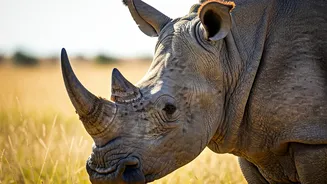Monkey's Prehensile Tail
Monkeys, especially those dwelling in the lush canopies of the rainforests, have evolved with prehensile tails—an extraordinary adaptation. These tails act
like an extra limb, providing unmatched gripping strength. They can wrap around branches, allowing the monkey to navigate with agility through the complex arboreal environment. The prehensile tail aids in balance, offering stability when leaping between trees. Its sensitive nature also assists in feeling textures and grasping objects. This versatile tool is indispensable for monkeys, facilitating everything from movement to foraging, and ultimately ensuring their survival in the wild. The prehensile tail allows monkeys to thrive in their arboreal habitats, highlighting the remarkable ways animals adapt to their surroundings.
The Scorpion's Stinger
Scorpions, notorious for their predatory prowess, utilize their tails for both defense and hunting. At the tip of the tail lies a venomous stinger, a formidable weapon employed to paralyze prey. When threatened, the scorpion swiftly arches its tail, delivering a potent sting. This venom is not always fatal to humans but is highly effective against insects and smaller animals, allowing the scorpion to subdue and consume its meals. The tail's segmented structure also provides flexibility, enabling precise movements during attacks and defense. The scorpion's tail exemplifies nature's precision, showcasing a carefully crafted tool that ensures survival in harsh environments. The venom is its primary means of defense, ensuring that potential predators will think twice.
The Beaver's Broad Paddle
Beavers, master builders of the aquatic world, rely on their broad, flat tails for numerous purposes. Primarily, the tail acts as a rudder, steering the beaver through the water with remarkable precision. This steering capability is essential for efficient swimming and navigating rivers and lakes. Beavers also use their tails for communication. When danger approaches, they slap their tails against the water's surface, creating a loud warning signal that alerts other beavers to potential threats. Furthermore, the tail functions as a storage location for fat reserves, providing essential energy during colder months. The beaver's tail demonstrates the importance of adaptation, supporting their aquatic lifestyle and ensuring the continuation of this remarkable species within its environment. It plays a pivotal role in these beavers' survival.
The Peacock's Display
Peacocks, the epitome of avian elegance, are celebrated for their extravagant tail feathers, which serve a primary role in attracting mates. During mating season, male peacocks unfurl their dazzling trains, showcasing a vibrant display of iridescent colors and intricate patterns. This flamboyant display is crucial for attracting peahens, the females of the species. The size, quality, and brightness of the tail feathers are direct indicators of the male's health and genetic fitness. Besides attracting mates, the peacock's tail also plays a role in intimidation. When threatened, the peacock can fan out its tail, making itself appear larger and more imposing to potential predators. The peacock’s tail shows nature’s artistic designs, with each element meticulously crafted for both survival and display.
The Rattlesnake's Warning
Rattlesnakes possess a unique tail adaptation – a rattle, composed of modified scales. This rattle serves as a warning system, alerting potential threats to the snake's presence. When agitated or threatened, the rattlesnake vibrates the rattle, producing a distinctive buzzing sound. This sound acts as a deterrent, warning larger animals to stay away, thus avoiding confrontation. The rattle's design allows for the efficient production of sound, making it effective even in noisy environments. The snake's tail acts as a critical component of its defense strategy, helping to conserve energy and reduce the risk of injury. The rattlesnake's tail highlights the intricate ways animals evolve for self-preservation.




